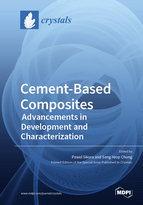Cement-Based Composites: Advancements in Development and Characterization
A special issue of Crystals (ISSN 2073-4352).
Deadline for manuscript submissions: closed (20 August 2020) | Viewed by 37139
Special Issue Editors
Interests: cement-based composites; construction materials; nanotechnology; sustainability; fire resistance
Special Issue Information
Dear Colleagues,
Concrete, a composite material composed of cement, water, aggregates, and often admixtures, is the most produced human-made material in the world. This material is an indispensable element of modern societies and is used in most of today's constructed engineering structures. Concrete structures need to satisfy specific characteristics in terms of mechanical performance and long-term durability so that they can be used without serious consideration of maintenance for many decades. Therefore, methods for the production of advanced high-performance composites are actively required. Due to their composite nature, the choice of proper individual components and their interaction and compatibility play a vital role in shaping the final properties of cement-based composites. In addition, numerical approaches to modeling and evaluating a material’s characteristics and properties can also be used to accelerate the material’s development.
The aim of this Special Issue is to showcase the latest research and advances in the field of cement-based composites. Original research papers, state-of-the-art reviews, and short communications are welcome.
Topics of interest include (but are not limited to) the following:
- the characterization of cement-based materials;
- hydration and microstructural formation;
- admixtures and additives;
- alternative and sustainable binders;
- waste materials and by-products in the production of cement-based composites;
- production of durable and high-performance cement-based composites;
- materials design for enhanced durability;
- incorporation of nanomaterials;
- durability and sustainability assessment;
- life-cycle assessment;
- concretes for special purposes (lightweight and heavyweight concretes);
- numerical simulation for evaluating the properties of cement-based composites; and
- multi-scale analysis for cement-based composites and structures.
Dr. Pawel Sikora
Prof. Dr. Sang-Yeop Chung
Guest Editors
Manuscript Submission Information
Manuscripts should be submitted online at www.mdpi.com by registering and logging in to this website. Once you are registered, click here to go to the submission form. Manuscripts can be submitted until the deadline. All submissions that pass pre-check are peer-reviewed. Accepted papers will be published continuously in the journal (as soon as accepted) and will be listed together on the special issue website. Research articles, review articles as well as short communications are invited. For planned papers, a title and short abstract (about 100 words) can be sent to the Editorial Office for announcement on this website.
Submitted manuscripts should not have been published previously, nor be under consideration for publication elsewhere (except conference proceedings papers). All manuscripts are thoroughly refereed through a single-blind peer-review process. A guide for authors and other relevant information for submission of manuscripts is available on the Instructions for Authors page. Crystals is an international peer-reviewed open access monthly journal published by MDPI.
Please visit the Instructions for Authors page before submitting a manuscript. The Article Processing Charge (APC) for publication in this open access journal is 2600 CHF (Swiss Francs). Submitted papers should be well formatted and use good English. Authors may use MDPI's English editing service prior to publication or during author revisions.
Keywords
- cement hydration
- concrete
- admixture and additives
- rheology
- mechanical performance
- durability
- nanomaterials
- numerical simulations
- special concretes







